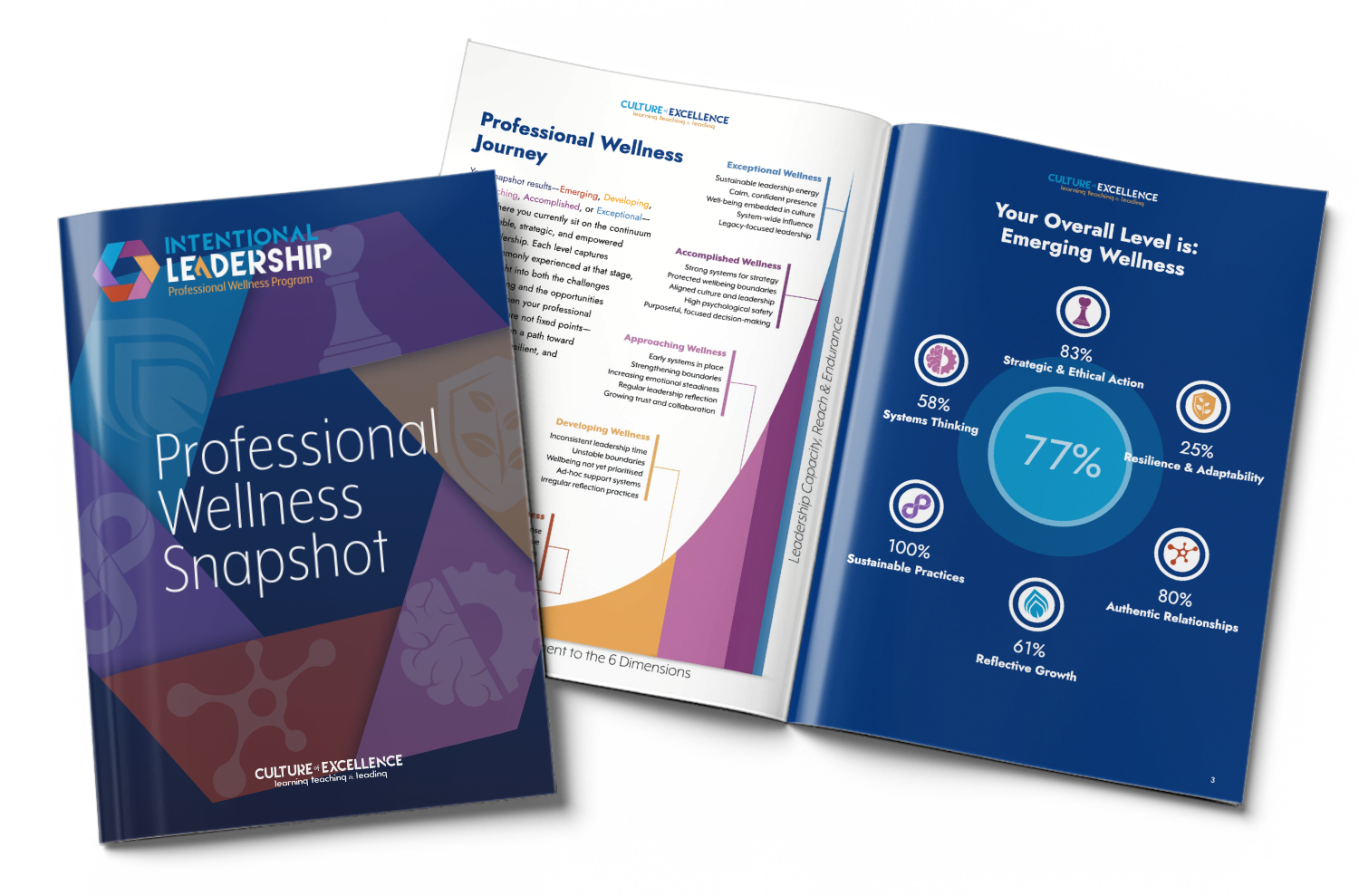
The Sustainability Myth
Why “just get through this term” isn’t a leadership strategy
This video explores the dangerous lie too many school leaders tell themselves: that things will settle, that rest will come later, that this stretch of overwork is temporary. It rarely is. And the longer leaders try to lead through collapse, the harder it is to rebuild what burnout has already eroded.
What part of your leadership feels “temporary”—but has actually become your norm?
Want to Lead With Steadiness—Not Strain?
Join our FREE Professional Wellness Workshop—a live session where we explore all six dimensions and help you refocus on what really sustains school leadership.

The Sustainability Myth
Why “just get through this term” isn’t a leadership strategy
“You can’t model balance if you’ve lost yours.” I’ve said that line in more workshops than I can count. And every time, it lands the same way: with a pause. A breath. A quiet realisation.
Because deep down, most school leaders already know—it’s true.
They’re expected to lead wellbeing initiatives while skipping their own breaks. To talk about resilience while answering emails at midnight. To model balance inside a culture that doesn’t allow it.
Burnout isn’t a badge of honour. It’s a warning sign. But we’ve built systems that reward the appearance of endurance over the presence of clarity. And over time, this becomes more than personal fatigue. It becomes cultural erosion.
The myth of overwork, institutionalised
The modern school leadership culture glorifies overextension:
- “She’s always the first one in and last one out.”
- “He never stops.”
- “They haven’t taken a real break in years.”
These aren’t throwaway lines—they’re performance cues. The 2021 Australian Principal Occupational Health, Safety and Wellbeing Survey found that nearly 60% of school leaders reported chronic work stress, with burnout and sleeping troubles rated as “high to severe” (Riley et al., 2021).
The leaders who are praised for always being on are often the first to quietly burn out—and the hardest to replace.
And it’s not unique to Australia. A UK report by the NAHT (2020) found that 74% of school leaders considered leaving the profession due to workload and wellbeing concerns.
Burnout doesn’t just damage leaders—it distorts what leadership looks like. You're bearing witness to the performance of busyness replacing the practice of leadership.
Truth 1: Burnout doesn’t build culture—it erodes it
When leaders run on depletion, it doesn’t just impact their own energy. It reshapes what others believe is normal—and necessary. As Bandura’s (1977) social learning theory reminds us, people learn most powerfully through observation. Your staff don’t model what you say. They model what they see—especially under pressure.
So when leaders normalise skipping rest, delaying boundaries, and overextending “for the team,” it gets internalised as expectation. And the culture silently shifts:
- Rest is weakness
- Boundaries are selfish
- Presence means productivity, not connection
What gets modelled becomes what gets multiplied. And if burnout is the model, you can’t be surprised when staff start burning out too.
Truth 2: The system rewards depletion—but forgets the cost
In many schools, the most visible leaders get the praise. They're the ones who respond first, who show up to everything, and who “never stop.” But here’s the problem: exhaustion is easy to applaud until it becomes unmanageable.
System leaders often confuse constant presence with deep leadership. But presence without reflection isn’t influence—it’s overexposure. As Heifetz and Linsky (2002) note in their work on adaptive leadership, “getting on the balcony”—stepping back to assess, realign, and reframe—is essential for long-term impact.
But few systems reward that type of invisible thinking. Instead, most reward visible output. And in the process, we lose strategic energy in favour of surface activity. The leaders who are praised for always being on are often the first to quietly burn out—and the hardest to replace.
Truth 3: Sustainable leadership protects what it wants to multiply
Sustainable leadership isn’t about doing less. It’s about doing what matters—with enough energy to do it again tomorrow. Research from Leithwood et al. (2006) points to “personal resourcefulness” and “emotional resilience” as key drivers of sustained school improvement. But those can’t grow if the leader is constantly depleted.
Burnout isn’t a badge of honour. It’s a warning sign.
Your staff don’t need you to be superhuman. They need you to be strategic:
- To say no when it protects alignment
- To pause when reflection is needed
- To recover as consistently as you lead
Presence isn’t just being in the room. It’s having enough energy to make the room better. The best leaders I know don’t push harder. They protect harder. Not out of selfishness, but so they can lead longer, with clarity and coherence.
The shift: From depletion to rhythm
Sustainability isn’t a personal value—it’s a leadership strategy. And it starts with questions, not policies:
- What am I giving my best energy to?
- What am I modelling for my team—especially under pressure?
- Where am I leading from survival instead of alignment?
Even a small reset—a true break, a tighter meeting, a clearer “no”—signals a shift. As Fullan and Quinn (2016) remind us, coherence is not a result of doing more—it’s the outcome of choosing what matters and communicating it consistently.
You don’t need a radical overhaul. You need rhythm. You need leadership that works with your energy, not against it. You need a culture that honours clarity—not chronic overwork.
Because if your leadership isn’t sustainable, neither is your impact.
What boundary or mindset shift has helped you lead more sustainably?
References
Bandura, A. (1977). Social Learning Theory. Englewood Cliffs, NJ: Prentice Hall.
Fullan, M., & Quinn, J. (2016). Coherence: The right drivers in action for schools, districts, and systems. Thousand Oaks, CA: Corwin Press.
Heifetz, R. A., & Linsky, M. (2002). Leadership on the Line: Staying Alive Through the Dangers of Leading. Boston, MA: Harvard Business Review Press.
Leithwood, K., Day, C., Sammons, P., Harris, A., & Hopkins, D. (2006). Successful School Leadership: What It Is and How It Influences Pupil Learning. Nottingham: National College for School Leadership.
Riley, P., See, B. H., Marsh, H., & Dicke, T. (2021). The Australian Principal Occupational Health, Safety and Wellbeing Survey 2021 Data Report. Australian Catholic University.

Not Sure What's Holding You Back?
Take our quick 2-minute Professional Wellness Snapshot to pinpoint where your biggest barrier lies—and which leadership dimension to strengthen next.